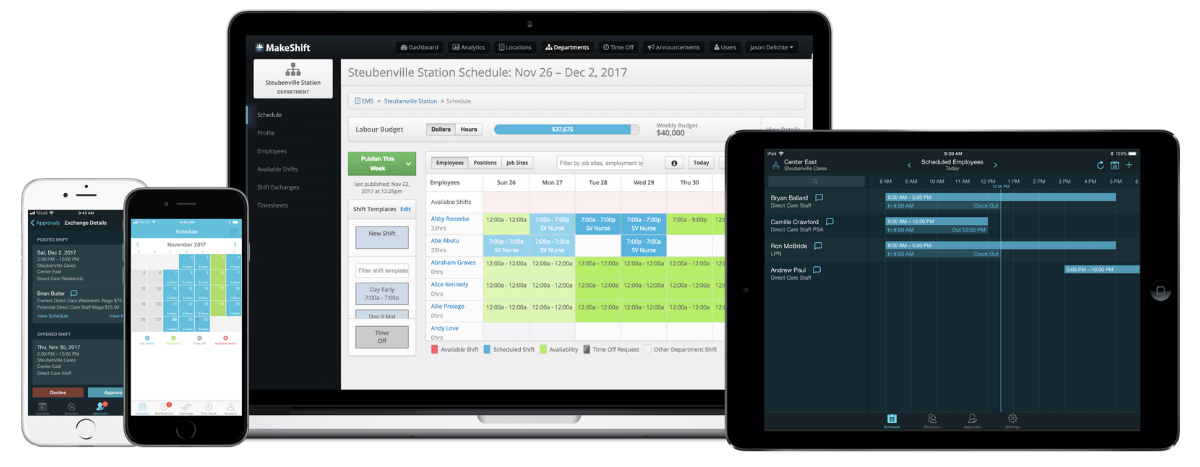Labor costs can run from 30% to 70% of total expenses, making them a critical focus for cost efficiency.
Unfortunately, many cost-cutting tips come at the expense of employee and customer satisfaction.
But what if you could reduce labor costs with smarter scheduling instead?
Spoiler alert — you can.
In this article, we’ll share 7 strategies for slashing labor costs without sacrificing your employee experience or understaffing.
- 1. Automate Staff Scheduling for High-Level WFO
- 2. Create Schedules Based on Labor Budgets
- 3. Automate Time & Attendance Tracking
- 4. Quickly Fill Staffing Gaps
- 5. Create Schedules Based on Historical Data
- 6. Offer Flexible Scheduling Options
- 7. Upgrade Employee Self-Serve Options
- FAQ
- MakeShift Offers Smarter Scheduling
1. Automate Staff Scheduling for High-Level WFO
Cutting labor costs requires working smarter and streamlining every process you can. Manual processes just won’t get you high-level workforce optimization that helps you reduce labor costs — automation is the only way.
- But don’t take our word for it, we’ll let the stats speak for themselves:
In organizations with 90% or better scheduling accuracy, at least 44% use automated scheduling & incur 41% less unplanned overtime.

- Companies using automated scheduling are 10x more likely to enable managers to broadcast open shifts over communication channels, saving managers’ time by filling the shift quickly.
Automated staff scheduling systems optimize staffing levels, boost scheduling accuracy, and give employees access to their schedules, enhancing efficiency and employee satisfaction.
To take it a step further, AI-powered scheduling streamlines shift planning while ensuring you use the right amount of staff to meet operational demands without sacrificing service quality.
Scheduling software with AI capabilities can analyze patterns in demand, employee performance (including sales performance), and cost factors. Then, it can suggest the most cost-effective schedules in a fraction of the time it takes to do this manually.
It can also automatically convert work hours into timesheets, reducing manual entry errors and ensuring payroll accuracy.
Connect scheduling software directly to your payroll system to transfer data seamlessly. This integration ensures all hours worked, including overtime and special pay rates, are accurately reflected in payroll calculations.
2. Create Schedules Based on Labor Budgets
Scheduling software allows you to input your labor budget and then offers scheduling suggestions that keep you on budget.
Better yet, software with AI-powered scheduling can do this for you.

Feed in your labor budget, and the AI will build budget-conscious schedules and deploy them. On-site managers can then make necessary tweaks.
AI provides real-time visibility into labor costs as schedules are created. This allows immediate adjustments to prevent budget overruns and align staffing with financial goals.
3. Automate Time & Attendance Tracking
Automate the tracking of employee clock-in and clock-out times using a digital system to ensure that payroll is ONLY processed for actual hours worked.

Automation offers precision to reduce overpayment due to:
- Human error
- Buddy punching
- Time theft
Still on the fence about automating time tracking? Check out these facts:
The US economy loses 50 million hours a year to errors in employee timesheets — that’s $7.4 billion a day.

- Companies can eliminate daily lost productivity and recapture $666,400.00 in yearly wages by automating time tracking.
Automating this process also reduces the need for manual oversight and corrections in timekeeping. This lowers administrative costs and reallocates that time to more productive tasks.

Automated alerts for abnormalities, like missed punches or overtime triggers, keep managers informed without constant monitoring.
4. Quickly Fill Staffing Gaps
Scheduling software facilitates real-time communication between management and staff. This helps quickly address shift changes, coverage needs, and urgent updates, keeping everyone informed and responsive.
Real-time communication allows for rapid response to staffing gaps, reducing the need for last-minute overtime or agency staffing, which are often more costly.
This enables proactive management of potential issues before they escalate into costly problems, such as understaffing or compliance issues.
5. Create Schedules Based on Historical Data
Use predictive analytics to forecast staffing requirements based on seasonal trends, historical data, and upcoming events.
This anticipates needs and prevents staff from having to make last-minute (preventable) scrambles.
By predicting staffing needs, you can avoid overstaffing during slow periods and understaffing during peaks, optimizing payroll expenditures.

Accurate forecasting allows for better planning, which minimizes reliance on overtime, saving significant labor costs. It also ensures your resources are allocated efficiently based on anticipated demand, preventing wasteful spending.
6. Offer Flexible Scheduling Options
Today, more companies offer more flexibility because it’s in high demand. Over 36% of surveyed employees valued their flexible schedule over PTO, and almost half said having a flexible schedule trumps salary.

Offering flexible work options increases employee morale and can impact your bottom line. Flexible work scheduling can increase retention, reducing the costs associated with high turnover, like hiring and training new employees.
Flex work can also cut medical costs by reducing employee fatigue.
Let’s run through 5 ideas:
1. Offer flex start and end times
Allowing employees to move their start or end times to accommodate their lives will reduce absenteeism and tardiness. This ensures the operation runs smoothly and inefficiencies don’t inflate labor costs.
2. If possible, offer remote or hybrid work options
These options can significantly reduce the overhead costs associated with physical workspaces, such as utilities and office supplies while offering your staff more flexibility.
3. Use on-call staff as a backup
This avoids overstaffing when demand isn’t high. For example, hospitals use on-call staff as backup for unpredictable demand. This alleviates the financial burden of overstaffing, ensuring you pay for labor only when needed.
4. Offer voluntary reduced hours
Not many will want this, but for some, it’s just what they need. They don’t want or can’t afford to quit their job, but they need reduced hours to accommodate other commitments.
Voluntary reduced hours can help match payroll expenses with your business needs without involuntary layoffs, maintaining morale and compliance.
5. Cross-train your staff
You may not think cross-training is a flexible work option, but bear with us.
Cross-training creates flexibility for both you and your employees. It helps to fill schedule gaps and allows staff more flexibility in which departments they work in.
A change of scenery and responsibilities can offer a much-needed recharge.
Once you have more cross-trained staff, you can employ skills-based scheduling that puts the right people in the right area at the right time.
7. Upgrade Employee Self-Serve Options
Self-serve scheduling options kill 2 birds with one stone. They empower employees through self-management and reduce labor costs associated with schedule management.
Self-service capabilities speed up response time to fill shifts and make changes, helping maintain operational efficiency without incurring extra costs or delays.

Choose scheduling software with an app where employees can easily:
- View their schedules
- Set availability
- Request changes
- Pick up open shifts
- Submit time-off requests
Go a step further by offering self-scheduling options. Self-scheduling encourages employees to take ownership of their work schedules and reduces the managerial burden of these tasks.

The Source, one of Canada's premier lifestyle retailers, switched to MakeShift
Scheduling, saving 150+ hours a year on payroll. Missed shifts dropped to almost zero because employees were empowered to take ownership of schedules. Check out their story.
FAQ
How can labor costs be reduced by optimizing schedules?
Labor costs can be reduced by optimizing schedules through strategic planning that matches staff availability with peak demand times. By ensuring the right number of staff are scheduled when needed most, you’ll minimize overstaffing during slow periods and understaffing during busy times. This balance helps reduce unnecessary overtime and ensures efficient use of labor resources.
How can labor costs be reduced?
Reduce labor costs by combining strategies like optimizing schedules, cross-training employees to handle multiple roles, and automating repetitive tasks. In addition, use data analytics to forecast labor needs accurately and make informed hiring decisions to maintain a lean and efficient workforce.
What are the 5 essential steps to controlling labor costs?
1. Forecast demand — Predict the labor needed based on historical data and upcoming trends.
2. Optimize schedules — Create schedules that align with demand, reducing idle time and avoiding overstaffing.
3. Cross-train employees — Equip staff with skills to perform multiple roles, providing flexibility in scheduling.
4. Monitor and adjust — Regularly review labor reports and make adjustments to avoid unnecessary costs.
5. Use technology — Implement scheduling and time-tracking software to streamline operations and ensure compliance.
How does technology reduce labor costs?
Technology reduces labor costs by automating scheduling and time-tracking, minimizing human error, and dishing up data-driven insights for better decision-making. Tools like scheduling software ensure optimal staff allocation, reduce overtime, and enhance productivity. Technology also facilitates better communication and coordination among team members, leading to more efficient operations.
MakeShift Offers Smarter Scheduling
MakeShift is an all-in-one solution that offers all 7 strategies above to help cut labor costs and modernize scheduling in a single swoop.
Let’s talk savings.
MakeShift users experience a:
- 21x ROI based on overtime savings
- 55% less time creating schedules
- 83% less time filling open shifts
We go beyond smart scheduling by offering an intelligent workforce management platform that supports:
- AI forecasting & workforce optimization
- Automated scheduling
- Labor budget scheduling
- Time & attendance
- Payroll/HR integration
Reduce Labor Costs the Smart Way
You already know that reducing labor costs doesn’t always mean layoffs and skeleton crews.
There’s a smarter way to cut your workforce costs and improve your employee experience simultaneously.
Ready to see what MakeShift can do for your organization? Schedule a FREE demo today.








